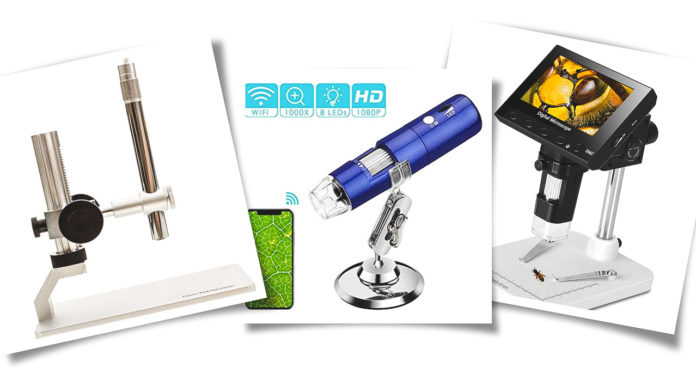Science is like selling—both are perceived as natural talents we deem either “in us” or “not.” Today, especially with the advent of evolving technology, this stereotype couldn’t be further from the truth. Anyone can appreciate the fascinating machinations of the natural world thanks to accessible new tools like the digital microscope, just like anyone can learn to close deals like clockwork. The biggest barrier to break is how we talk to ourselves about ourselves. After that, it just takes a little studying and practice.
Once upon a time, microscopes might’ve been mostly useful to scientists, specialists, and researchers, but simplified features adapted to everyday life have released these tools up to all manner of individuals.
The most important factor to consider when starting your search for a digital microscope lies in your subject matter.
Microscopes magnify the subjects under their lenses, allowing for careful study and analysis not possible with the human eye alone. This machinery has been around since the advent of corrective eyeglasses in the thirteenth century, leveraging the thickness and angles of glass to produce society-altering new capabilities. Japanese company Hirox Co. Ltd. introduced the first digital microscope in 1986, connecting their microscope to a computer to display the images beneath its lens, rather than requiring each researcher to inefficiently peer through its uncomfortable eyepiece one by one. Built-in monitors came about by the early 2000s, but it wasn’t until 2015 that the digital microscope could connect to computers via USB.
The jump from standard to digital microscopes enables all kinds of new utilities. First and foremost, they allow the viewer to regard their subject on a much larger scale, a screen rather than that miniscule traditional eyepiece. Innovations in accompanying software further enables the viewer to grab screen captures of their subjects, taking videos, saving files of their findings on the spot, and sharing their studies in real-time with an audience. Not only does this all reduce eye fatigue, but it also cuts costs. You can perform procedures for an entire room full of people rather than outfitting each individual with their own equipment.
While microscopes are still necessary fare for scientists, engineers, and other “left brain” professions, they’re also great tools for hobbyists interested in studying coins or stamps or bugs or foliage for fun. With models growing smaller and cheaper every year, they can even just make a fun party trick. Everything in the world is made of something—even the aglets on the end of your shoelaces are built from an unconscionable amount of miniscule, vibrating atoms. There’s a lot to discover out there if you have the tools and curiosity to explore for yourself. That, after all, is what the scientific spirit is all about.
What to know about digital microscopes before buying
Research requirements
The most important factor to consider when starting your search for a digital microscope lies in your subject matter. How small are the specimens you’ll be studying? Are they transparent or solid?
There are two types overarching types of digital microscopes to accommodate your particular research requirements:
- Compound Microscope: Compound microscopes (also known as high power microscopes) are required for intensive activities like biology or chemistry. This heavy-duty machinery can not only magnify subjects by figures in the thousands, but they also shine light through the subject to increase its visibility. They are best used for subjects like blood cells or tiny organisms in pond water.
- Stereo Microscopes: Stereo microscopes (or low power microscopes) are better suited for coin collectors, stamp collectors, entomologists, geologists, jewelry makers, and anyone interested in larger specimens. Their magnification power typically maxes out around 80x the subject’s original size.
Specifications
Once you’ve narrowed down your options a bit, pare them down even further by identifying the specific features you’d like to find in your new digital microscope. Because these tools interact with computers, there’s a surprising number of particulars to consider.
- Viewing method: Some digital microscopes come equipped with their own LCD screen to display your magnified specimen, while others link to your computer (or even your phone!) to display the results. Consider which method you like best.
- Connection method: How would you like your microscope to connect to your viewing method of choice? Today, microscopes can share their findings via USB cords, oldschool S cords, and even wirelessly over WiFi!
- Software Compatibility: If you’re looking for a digital microscope that’ll display your findings through external hardware like your phone or computer, make sure its accompanying software is compatible with your operating system. Nothing like going through all that search just to plug your new microscope into your sparkly new Macbook and discover it only works with Windows!
- Total cost: Of all the above factors, the difference between a compound and stereo microscope will exert the biggest impact on how much your new gear costs. However, each of the bells and whistles listed should be leveraged against your needs to find the machine that best suits your budget.
Caring for your Digital Microscope
Once you choose your digital microscope and get it in working order, treat it well to extend its usefulness. Every model comes with its own intricacies, but these best practices will help you out across the board.
- Handling: Much like eyeglasses, you can extend the longevity of your digital microscope significantly simply by handling it correctly. When using a larger microscope that comes with its own stand, be sure to always lift from the base, rather than the neck or some other appendage. Portable microscopes often last longer when you take care to employ them on flat surfaces where possible. Of course, treat its lens(es) like you also would a treasured pair of eyeglasses, keeping them safe from spare particles.
- Cleaning: No matter what you’re using your microscope to observe, it’s imperative to clean its lens after each use. Messier subjects, of course, necessitate even more intense care. Lenses are far more fragile and costly to replace than one might initially think. Not any old solvent and cloth will do. There are specific wipes and cleaning solutions made for microscopes. Concave lenses require application of the solution with a q-tip, while convex lenses need the same with a cloth or paper. Proper care will keep your images clear longer.
- Storage: Keep your digital microscope safe when it’s not in use by securing a particular storage space where there’s no risk of falls or other falling debris, where it won’t get bumped around in the chaos of everyday life. Make sure to store it in any hardware that comes in the box, or at least a dust cover if it comes unaccompanied.
- Maintenance: As you embark upon your explorations with your trusty new tool, it will inevitably accrue some wear and tear. Keep your machine up to snuff by thoroughly reading the manual to learn what to look out for, what to replace, and how to continually care for your digital microscope. Take it for annual maintenance check ups the same way you would for your health. The more complex your microscope, the more maintenance will maintain a front of mind position.
5 Best Digital Microscopes
Opti-Tekscope Digital USB Microscope
This elegant feat of technology makes an excellent fit for beginners and aficionados alike. This digital microscope from Optik-Tekscope connects to Mac, Windows, and Chromebook computers through their respective, pre-installed photo apps. The company also includes their own software with purchase. Built from aluminium in an ultra-sleek design, this lightweight digital microscope also packs some power, magnifying subjects up to 200x. With fully adjustable lighting offered by 8 LED lights, this all-around winner stages a scientific show fit for the silver screen.
Firefly DE300 Polarized Handheld USB Digital Microscope
Oasis Scientific’s compact, handheld digital microscope proves one of the pricier options on the market, but only for the sophistical features it encompasses. This machine holds an incredible capacity for magnification, displaying subjects at up to 150x digitally through a USB connection. Anyone who studies shiny subjects like skin, gems, metals, or liquids will appreciate this microscope’s 12 distinct levels of polarization, crucial to quelling glare. This high-quality technology offers an excellent tool for people engaged with at-home medical examinations, graphic design, or examining jewelry and other metals.
OMAX 40X-2500X Trinocular Lab Microscope
Looking for a digital microscope with a little more firepower? Look no further than this impressive digital compound microscope by OMAX, replete with all the bells and whistles every ambitious laboratory deserves. Subjects set on its sturdy observation stage, under three lenses and one camera, can be magnified according to six preset levels topping 2500x original size. The only downside to this very powerful offering from OMAX is that its digital viewing software only works on Windows computers. Viewers can either observe images through the traditional eyepieces adjustable for varying interpupillary distances, or on their Windows computer through USB connection.
ROTEX Wireless Digital Microscope
Certain studies encourage, even require, field work. If your subjects live in the wild or you just prefer fresh air, then this wireless digital microscope from ROTEX might be the best fit for you. This lightweight gear frees users from cumbersome construction or cords, connecting directly to your phone to display magnified images via WiFi. It’s even small enough to fit in your pocket! Once you’ve connected this microscope to the internet and its companion app on your phone, enjoy magnification power up to 1000x original size, illuminated by eight built-in LED lights. You can, of course, still view your subjects on a computer through USB connection using the same cord you’ll charge this microscope with.
Koolertron 4.3 inch Full Color LCD Digital USB Microscope
Koolertron has crafted this all-in-one digital microscope complete with its own crystal clear LCD screen for easy viewing everywhere. At 4.3 inches, this screen ranks one of the most expansive available on the market today. According to its specs, this microscope magnifies subjects up to 600x. Fully transportable in the realest sense of the world, this digital microscope includes its own rechargeable and reliable power source. Furthermore, users can save screenshots of their subjects to a microSD card, with up to 32 GB of storage. Take that well-loved and well-nourished scientific spirit everywhere you go with this unbeatable digital microscope.















